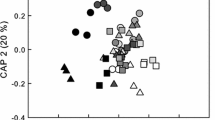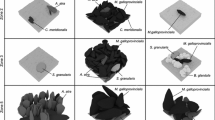Summary
A variety of simple models have been proposed to describe ecological succession (e.g., Connell and Slatyer 1977), but these models do not address some agents that may increase complexity. To determine the complexity of a natural sequence, four null hypotheses were tested: (1) seasonality of growth, recruitment, and mortality does not influence succession; (2) the interspecific interactions that produce successional change are the same throughout the sequence; (3) consumers have no influence on succession, and (4) small scale spatial variation in establishment and mortality does not occur. These hypotheses were tested in a low zone rocky intertidal community normally dominated by the surfgrass Phyllospadix scouleri on the Oregon coast.
Succession experiments initiated in different seasons and an herbivore exclusion experiment falsified each of these hypotheses. At two sites (Boiler Bay and Squaw Island) experimental plots that were cleared in the spring were first colonized by Ulva sp., but those cleared in other seasons were first colonized by Phaeostrophion irregulare. Ulva appears adapted to colonize space made available by winter storms, whereas Phaeostrophion takes advantage of space made available by sand movement in the fall. Another seasonal pattern was the sharp decline in total algal cover in the fall, when wave action increased. At Squaw Island, the presence of Phaeostrophion established in fall and winter significantly inhibited the summer establishment of Ulva, though Ulva occupied some space epiphytically. In contrast, at Boiler Bay, a different, stronger type of interspecific interaction occurred: Phaeostrophion totally inhibited the establishment of filamentous diatoms. The cover of Ulva in the summer was also influenced by herbivores, but Ulva cover declined in the fall in both herbivore exclusions and controls, suggesting that herbivores were not solely responsible for its replacement. Local variation was demonstrated, because after three years of succession, replicate plots often differed. The early colonists, Phaeostrophion and Ulva, continued to dominate some plots; in other plots they had been replaced by middle successional species, including Cryptosiphonia woodii and Odonthalia floccosa. In still other plots Rhodomela larix had replaced other species. Similarly complex successional sequences occur in many natural communities. Thus, the features that simple models do not address may add complexity to succession, and for some communities different approaches must be developed.
Similar content being viewed by others
References
Abbott IA, Hollenberg GJ (1976) Marine algae of California. Stanford University Press, Stanford
Anderson EK, North WJ (1966) In situ studies of spore production and dispersal in the giant kelp Macrocystis. In: Young EG, McLachlan JL (eds) Proc Int Seaweed Symposium 5, Halifax, 73–85, Pergamon Press, New York
Best B (1964) Feeding activities of Tegula funebralis. Veliger 6 (Suppl):42–45
Clements FE (1916) Plant succession: An analysis of the development of vegetation. Carnegie Inst Wash Publ 242:1–512
Connell JH, Slatyer RO (1977) Mechanisms of succession in natural communities and their role in community stability and organization. Am Nat 111:1119–1144
D'Antonio CM (1982) Population and community ecology of the red alga, Rhodomela larix (Turner) C. Agardh, on the central Oregon coast. MS Thesis, Oregon State University, Corvallis, Oregon
Dayton PK (1973) Dispersion, dispersal, and persistence of the annual intertidal alga, Postelsia palmaeformis Ruprecht. Ecology 54:433–438
Dean TA, Hurd LE (1980) Development in an estuarine fouling community: The influence of early colonists on later arrivals. Oecologia (Berl) 46:295–301
Deysher L, Norton TA (1982) Dispersal and colonization in Sargassum muticum (Yendo) Fensholt. J Exp Mar Biol Ecol 56:179–195
Drury WH, Nisbet ICT (1973) Succession. J Arnold Arbor 54:331–368
Emerson SE, Zedler JB (1978) Recolonization of intertidal algae: An experimental study. Mar Biol 44:315–324
Foster MS (1975) Algal succession in a Macrocystis pyrifera forest. Mar Biol 32:313–329
Foster MS (1982) Factors controlling the intertidal zonation of Iridaea flaccida. J Phycol 18:285–294
Gaines SD (1983) Herbivory and between-habitat diversity: The differential effectiveness of a marine plant defense. Ecology in press
Gerwick WH, Lang NJ (1977) Structural, chemical, and ecological studies on iridescence in Iridaea (Rhodophyta). J Phycol 13:121–127
Gibbs RE (1902) Phyllospadix as a beach-builder. Am Nat 36:101–109
Green CH, Schoener A (1982) Succession on marine hard substrata: A fixed lottery. Oecologia (Berl) 55:289–297
Hansen JE (1977) Ecology and natural history of Iridaea cordata (Gigartinales, Rhodophyta) growth. J Phycol 13:395–402
Hansen JE, Doyle WT (1976) Ecology and natural history of Iridaea cordata (Rhodophyta: Gigartinaceae): Population structure. J Phycol 12:273–278
Harper JL (1977) Population biology of plants. Academic Press, New York
Hay CH, South GR (1979) Experimental ecology with particular reference to proposed commercial harvesting of Durvillaea (Phaeophyta, Durvilleales) in New Zealand. Bot Mar 22:431–436
Hils MH, Vankat JL (1982) Species removals from a first-year old-field plant community. Ecology 63:705–711
Horn HS (1981) Some causes of variety in patterns of secondary succession. In: West DC, Shugart HH, Botkin DB (eds) Forest succession, 24–35, Springer Verlag, New York
Hruby T (1975) Seasonal changes in two algal populations from the coastal waters of Washington state. J Ecol 63:881–890
Kain JM (1975) Algal recolonization of some cleared subtidal areas. J Ecol 63:739–765
Kay AM, Keough MJ (1981) Occupation of patches in the epifaunal communities on pier pilings and the bivalve Pinna bicolor at Edithburgh, South Australia. Oecologia (Berl) 48:123–130
Keever C (1950) Causes of succession on old fields of the Piedmont, North Carolina. Ecol Monogr 20:229–250
Keever C (1979) Mechanisms of plant succession on old fields of Lancaster County, Pennsylvania. Bull Torrey Bot Club 106:299–308
Littler MM, Littler DS (1980) The evolution of thallus form and survival strategies in benthic marine macroalgae: Field and laboratory tests of a functional form model. Am Nat 116:25–44
Lubchenco J (1980) Algal zonation in the New England rocky intertidal community: An experimental analysis. Ecology 61:333–344
Lubchenco J, Gaines SD (1981) A unified approach to marineplant herbivore interactions. I. Populations and communities. Ann Rev Ecol Syst 12:405–437
Lubchenco J, Menge BA (1978) Community development and persistence in a low rocky intertidal zone. Ecol Monogr 48:67–94
Markham JW (1973) Observations on the ecology of Laminaria sinclairii on three northern Oregon beaches. J Phycol 9:336–341
Marks PL (1974) The role of pin cherry (Prunus pensylvanica L.) in the maintenance of stability in northern hardwood ecosystems. Ecol Monogr 44:73–88
Mathieson AC (1965) Contributions to the life history and ecology of the marine brown alga Phaeostrophion irregulare S. et G. Ph.D. dissertation, University of British Columbia, Vancouver, Canada
Menge BA (1976) Organization of the New England rocky intertidal community: Role of predation, competition and environmental hetrogeneity. Ecol Monogr 46:355–393
Neushul M, Foster MS, Coon DA, Woessner JW, Harger BWW (1976) An in situ study of recruitment, growth and survival of subtidal marine algae: techniques and preliminary results. J Phycol 12:397–408
Northcraft RD (1948) Marine algal colonization on the Monterey Peninsula, California. Am J Bot 35:396–404
Paine RT (1977) Controlled manipulations in the marine intertidal zone, and their contributions to ecological theory. In: The changing scenes in natural sciences 1776–1976. Academy of Natural Sciences, Special Publ 12:245–270
Paine RT (1979) Disaster, catastrophe, and local persistence of the sea palm Postelsia palmaeformis. Science 205:685–687
Paine RT, Levin SA (1981) Intertidal landscapes: disturbance and the dynamics of pattern. Ecol Monogr 51:145–178
Robles CD, Cubit J (1981) Influence of biotic factors in an upper intertidal community: Dipteran larvae grazing on algae. Ecology 62:1536–1547
Shugart HH, West DC, Emanuel WR (1981) Patterns and dynamics of forests: An application of simulation models. In: West DC, Shugart HH, Botkin DB (eds) Forest succession, 74–94, Springer Verlag, New York
Slocum CJ (1980) Differential susceptibility to grazers in two phases of an intertidal alga: Advantages of heteromorphic generations. J Exp Mar Biol Ecol 46:99–110
Sokal RR, Rohlf FJ (1969) Biometry. WH Freeman and Co, San Francisco
Sousa WP (1979) Experimental investigations of disturbance and ecological succession in a rocky intertidal algal community. Ecol Mongr 49:227–254
Sousa WP, Schroeter SC, Gaines SD (1981) Latitudinal variation in intertidal algal community structure: The influence of grazing and vegetative propagation. Oecologia (Berl) 48:297–307
Southward AJ, Southward ED (1978) Recolonization of rocky shores in Cornwall after use of toxic dispersants to clean up the Torrey Canyon spill. J Fish Res Bd Can 35:682–706
Sutherland JP (1974) Multiple stable points in natural communities. Am Nat 108:859–873
Sutherland JP (1980) Dynamics of the epibenthic community on roots of the mangrove Rhizophora mangle, at Bahia de Buche, Venezuela. Mar Biol 58:75–84
Sutherland JP, Karlson RH (1977) Development and stability of the fouling community at Beaufort, North Carolina. Ecol Monogr 47:425–446
Turner T (1982) Community organization and succession in rocky intertidal surfgrass beds. Ph.D. dissertation, Oregon State University, Corvallis, Oregon
Turner T (1983) Facilitation as a successional mechanism in a rocky intertidal community. Am Nat 121:729–738
Underwood AJ, Jernakoff P (1981) Effects of interactions between algae and grazing gastropods on the structure of a low-shore intertidal algal community. Oecologia (Berl) 48:221–233
Van Hulst R (1980) Vegetation dynamics or ecosystem dynamics: Dynamic sufficiency in succession theory. Vegetatio 43:147–151
Author information
Authors and Affiliations
Rights and permissions
About this article
Cite this article
Turner, T. Complexity of early and middle successional stages in a rocky intertidal surfgrass community. Oecologia 60, 56–65 (1983). https://doi.org/10.1007/BF00379320
Received:
Issue Date:
DOI: https://doi.org/10.1007/BF00379320




